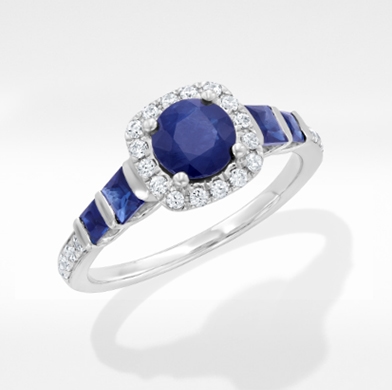
Amethyst
Amethyst is prized for its rich purple hue as well as its healing and protective properties. Coming in at a 7 on the Mohs hardness scale, amethyst is suitable for jewellery that is worn every day.
Aquamarine
With its striking ice-blue colour that can appear colourless at certain angles, aquamarine is a unique gemstone that some believe has the power to bring foresight to those who wear it. At 7.5-8 on the Mohs scale, it’s suitable for everyday wear.
Citrine
Prized for its vibrant yellow colour that ranges from pale to deep golden-orange, citrine is believed to bring hope to anyone who wears it with a unique ability to promote relaxation. At a 7 on the Mohs scale, citrine is relatively durable.
Cubic Zirconia
Cubic zirconia is a manufactured diamond alternative made up of a crystalline form of zirconium dioxide. Used in all types of jewellery, from rings to earrings to necklaces, cubic is versatile and easy to work with.
While it is less brilliant and reflective than a natural diamond, cubic zirconia is the more affordable option if a natural diamond isn’t in the budget.
Emerald
One of the most valuable gemstones on the market, emeralds can be even more expensive than diamonds. Ranging from pale green to bluish-green, they were a favourite of Cleopatra. At 7.5 to 8 on the Mohs scale, emeralds are suitable for all types of jewellery.
Garnet
The traditional birthstone for January, the garnet is a classic gemstone with roots stretching back to the Ancient Egyptians. Available in almost every colour, with the most popular being red, a garnet ranks at a 7 on the Mohs scale, making it a popular choice for most jewellery.
Jade
Known for its toughness and durability, jade has historically been used for a wide variety of things, from weapons to ornaments to jewellery. The Maori, Ancient Egyptians, and the Chinese valued jade as a source of wisdom. It can come in many colours, but the most recognized is green, which represents the heart chakra.
Morganite
With a hue ranging from soft peach-pink to violet-pink, morganite is said to be the gemstone of the universal heart. At a 7.5 – 8.0 on the Mohs scale, morganite is a popular engagement ring gemstone, either on its own or paired with diamonds.
Opal
Considered symbols of hope, purity and truth, there is no gemstone quite like the iridescent opal. Exhibiting multi-coloured flashes of light when viewed from different angles, each opal is unique. At 5.0 – 6.5 on the Mohs hardness scale, they are more delicate than some other gemstones and should be treated with care.
Onyx
While generally thought of as solid black, onyx actually ranges from white to black and may have white bands or ribbons. At 6.5 – 7.0 on the Mohs hardness scale, it’s a little less durable than other gemstones but still suitable for everyday wear.
Peridot
Ranging from soft, pale green to olive green, peridot is a distinct gemstone with a long history. The birthstone for August, peridot is said to offer protection from deception and provide inspiration to anyone who wears it. At a 6.5 – 7.0 on the Mohs scale, peridot is a popular choice for everyday wear.
Quartz
The most abundant of all minerals on earth, there are many different gemstones that are variations of quartz, including amethyst and citrine. Pure quartz is clear and colourless but can also range from pale pink to rich black. With a rating of 6.5 – 7.0 on the Mohs hardness scale, quartz is generally suitable for everyday wear.
Ruby
One of the four precious gemstones and the birthstone for July, rubies hold the title of “King of the Gems”. Ranging from deep red to pink to brownish hues, a ruby is known for its vibrancy and association with love and passion. Coming in at 9.0 on the Mohs hardness scale, rubies are perfect for jewellery.
Sapphire
One of the four precious gemstones and the birthstone for September, sapphires are known for their signature blue colour, but they also come in violet, green, yellow, pink, orange, and white. At a 9.0 on the Mohs hardness scale, sapphires are a practical—and beautiful—choice for all types of jewellery.
Spinel
Ranging from violet and blue to orange, pink, red, and even black, spinel is a lesser-known gemstone that has been called “History’s Most Under-Appreciated Gem”. It rates an 8.0 on the Mohs hardness scale, so spinel is just as suitable for jewellery as more popular gems like rubies and sapphires.
Tanzanite
First discovered in 1962, tanzanite has been gaining in popularity as an alternative to diamonds in engagement rings. It ranges from light to dark violet-blue and is coveted by those who have an eye for the elegant and unusual. At 6.0 – 7.0 on the Mohs hardness scale, tanzanite isn’t as durable as a diamond and should be handled with care.
Topaz
From Ancient Greeks to Renaissance Europeans, topaz has been a popular gemstone for centuries. With a wide colour range including blue, green, purple, yellow, orange and red, topaz is a versatile and affordable option for jewellery. At 8.0 on the Mohs hardness scale, topaz is a very durable gemstone that works in all styles of jewellery.


















